|
Tip 84 (July 2015)
The Paoli 60M Monoblock Tube Amplifier
by Dick Olsher
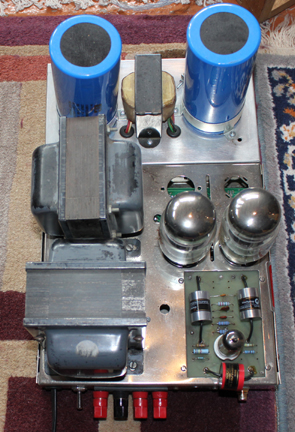 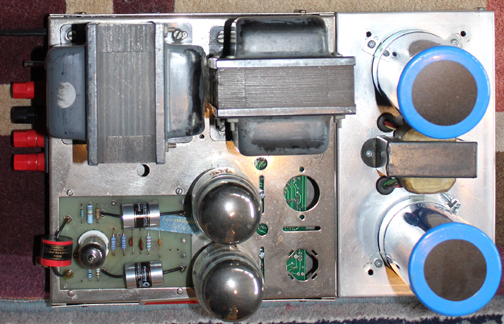 This is one of the rarest tube amplifiers you’re ever likely to come across on the used market. Only about 200 pair were ever produced in the early 1970s. It was referred to as a hot-rodded Dynaco Mk III by non-other than the late Harvey Rosenberg, which is actually an inaccurate description. More to the point, it was a highly modified Mk III featuring an extension chassis with added power supply capacitance and a stiff screen grid supply. Yes, that’s right, the 60M was a fixed-bias pentode amplifier designed to compete against the likes of the Audio Research 76A. The original amps used 8417’s although 6550's could be substituted. It was built and distributed by Paoli High Fidelity Consultants, Inc., located in Paoli, PA, under the direction of Eugene Coggins. I tracked Gene down several years ago and asked him to share as much as he could recall about the 60M . Here’s what he had to say: This is one of the rarest tube amplifiers you’re ever likely to come across on the used market. Only about 200 pair were ever produced in the early 1970s. It was referred to as a hot-rodded Dynaco Mk III by non-other than the late Harvey Rosenberg, which is actually an inaccurate description. More to the point, it was a highly modified Mk III featuring an extension chassis with added power supply capacitance and a stiff screen grid supply. Yes, that’s right, the 60M was a fixed-bias pentode amplifier designed to compete against the likes of the Audio Research 76A. The original amps used 8417’s although 6550's could be substituted. It was built and distributed by Paoli High Fidelity Consultants, Inc., located in Paoli, PA, under the direction of Eugene Coggins. I tracked Gene down several years ago and asked him to share as much as he could recall about the 60M . Here’s what he had to say:
“I have been trying to recall as much as possible about the unit. It really goes back into the cobwebs of my mind. The original design or modification of the Dynaco 60 watt Mk III mono amp was done by Walter Key of Virginia. If you recall, I was importing Decca phono cartridges at that time and Walter thought we would have a ready-made network for product distribution. Walter's modifications to the unit removed the power supply tube and replace it with a simple diode bridge. He also added a separate power supply for the screen voltages. Large electrolytic capacitors were added to the B+ supply along with some minor changes to the audio driver circuit. We used nothing but the best quality parts we could find to provide long term reliability.
What made the sound of the 60M so transparent was the simplicity of the audio circuit. Equally important was the stabilizing of the tubes screen voltage supply. And to a certain extent the B+ supply on the driver tube. (The B+ stability on the output tubes was not that critical). Therefore the fewer electronic components the audio signal had to "travel" through coupled with screen voltage stability, gave the 60M its superior sound. However, the down side was if any single electronic part failed, you heard it right away. I must say that the only "failures" we experienced was replacement of tubes. Of all the units built, only one had a circuit board part fail.
Unfortunately, about three years into production, Dynaco was sold and ceased production of the Mk III. Dave Conklin of Butler NJ came up with a design that was completely our own which included custom wound output transformers. But with the misfortune of dealing with Decca, all our capital was dried up and we never produced the amplifier except for about ten units. …That coupled with Dynaco being sold, Decca sending me junk and Linn Sondek transferring all dealers to some guy in Indianapolis without one word as to why, I sold Paoli for one Dollar. Regarding the number of 60M amplifiers we made, I can't find any specific numbers since most of the files have been tossed. But I believe we made about 200 pair before Dynaco stopped manufacturing the basic Mk III.”
It was J. Gordon Holt (JGH) who put the Paoli amps on the map. He was already well familiar with the sound of the Dynaco Mark III amp having reviewed it for High Fidelity Magazine a few years before. A short excerpt from his review of the 60M monoblocks follows:
“This is a rather difficult report for us to write, as the amplifier in question -- a modified Dyna Mark III was designed by Walter Key, who is now a regular contributor to Stereophile, and it is being manufactured by Eugene Coggins of Paoli Hi-Fi Consultants, who is a long-time friend of Ye Editor and publisher. Now that we have admitted that it is impossible for us to be impartial, we shall climb out on a limb and state that, although we have heard many amplifiers that tested better than this one, it is nonetheless (in our biased. opinion, anyway) the most nearly-perfect tube amplifier it has been our good fortune to hear to date, and (except for use with speakers that must have the driving power and low-end. tautness of solid-state electronics) probably the best sounding power amp that money can buy. The fact that it costs a little more than half (for two stereo channels) the price of an Audio Research Dual 76, and is a hair tighter, crisper, and better-defined than the D-76, would seem to make it the choice for the perfectionist who is willing to forego Audio Research's beautiful appearance and unarguable prestige.”
It was a chance comment by JGH that got me hooked on the 60M. One afternoon in Santa Fe in the early 1980s he mentioned that the 60M was the sweetest amp he had ever heard. It was an offhand comment that could have gone no further than my short-term memory bank; instead it made quite an impression and became lodged in the deep recesses of my subconscious. It took me a while, over 20 years to be precise, before I was able to pick up a pair of 60M off eBay. As with almost all vintage gear I’ve bought off eBay there were issues that needed repair. The feedback network and driver compensation circuit values had been altered, probably by a previous owner (see schematic below which shows the factory version of Walter Key’s design by Dave Conklin with unauthorized handwritten alterations). Additionally, one channel was clipping prematurely and unable to maintain stable DC bias.
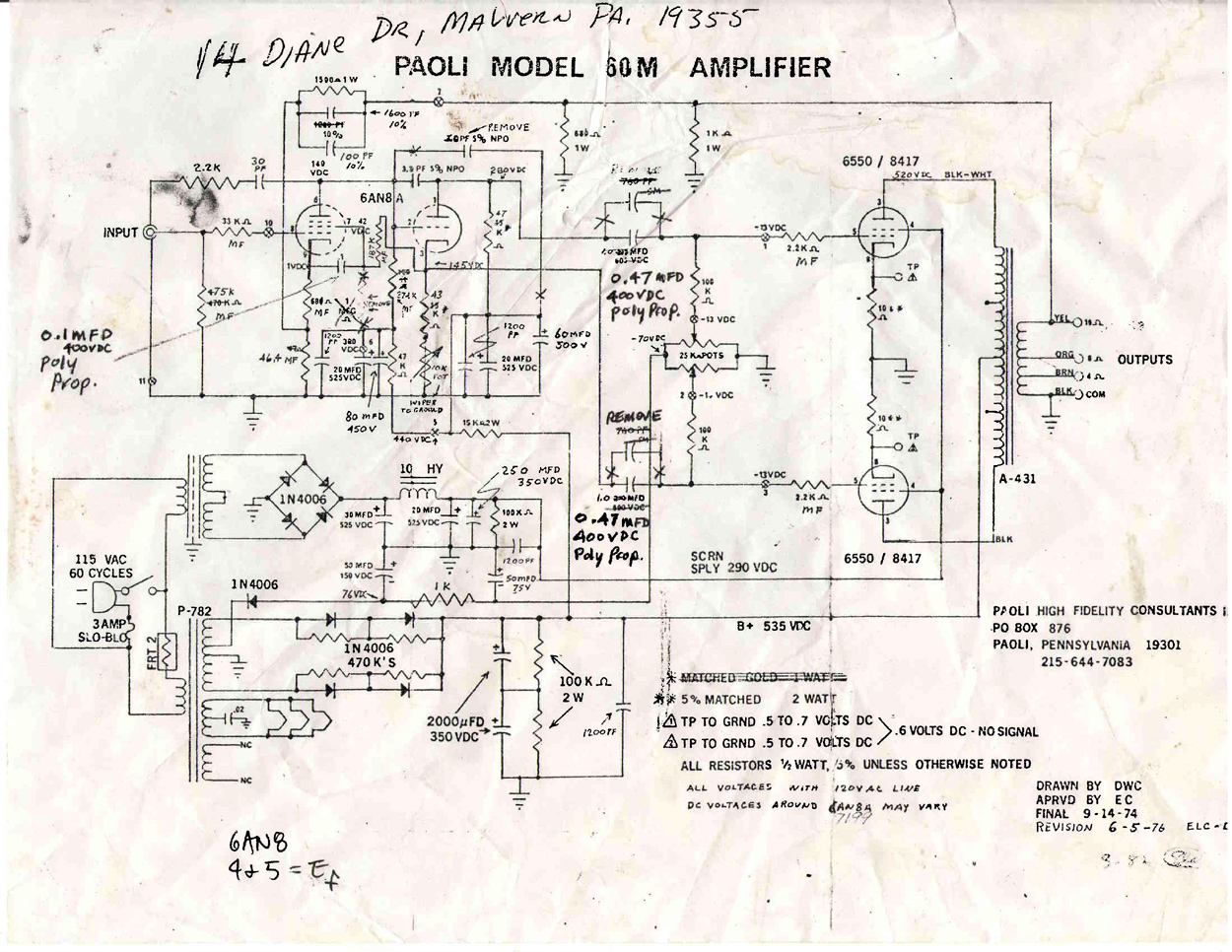 |
It took me another 10 years before I decided to take the plunge and seriously look at repair and upgrade options. It turned out that Joe Curcio, the Dynaco Doctor (http://www.curcioaudio.com/index.htm), used to work on the Paoli 60M for Eugene Coggins and thus seemed to be the perfect guy to restore these amps. He thought that the premature clipping may be due to leaky caps or issues in the power supply. The shifting bias he said is very common with old tube amps that used phenolic grade output tube sockets with nickel plated contacts. The plating deteriorates leaving the base metal that oxidizes very easily. The net result is loss of bias and frequently output tubes running at high bias currents thus significantly reducing tube life. Likewise, without seeing the bode plots to support the change, he was very concerned about the value change of the cap in the feedback network as well as removing the driver compensation cap (off the plate of the pentode voltage amp). According to Joe, “These are critical for stability and virtually no modifiers have any idea of what they are doing with these changes. The only scientific procedure is to run a bode plot (gain-phase) with the loop closed (I own a $15,000 Venable analyzer for this purpose).”
In the spring of 2011 I sent my 60M amps to Joe for repair and upgrade. I decided to have Joe install the CAE ASM-BCS auto set bias module so that I would have the flexibility to roll in various beam power tubes. Joe tells me that he hates the 8417 which he considers one of the most non-linear tubes ever made and strongly suggested that I run my favorite 6550. He says that among pentodes the 8417 measures very poorly especially when compared to the 6550. Specifically, he says that they show a lot of odd order spikes in the FFT's which is responsible for a hard and dissonant sonic signature. I’m not sure that the 8417 is that bad a power tube, but I can tell you that I currently use the Russian Mallard reissue KT88 which I clearly prefer to the 8417.
Considerable time was spent by Joe optimizing the feedback and compensation networks. He eventually settled on a scheme that gives an impressive 60-degree phase stability margin. The final amplifier schematic according to Joe Curcio is shown below. It is the original Walter Key design (prior to mods by Dave Conklin)with improved compensation and biasing of the 6AN8 G2 terminal in the pentode section. It should be possible to transform any Dynaco Mk III to this Paoli 60M design since both the power and output transformers are stock.
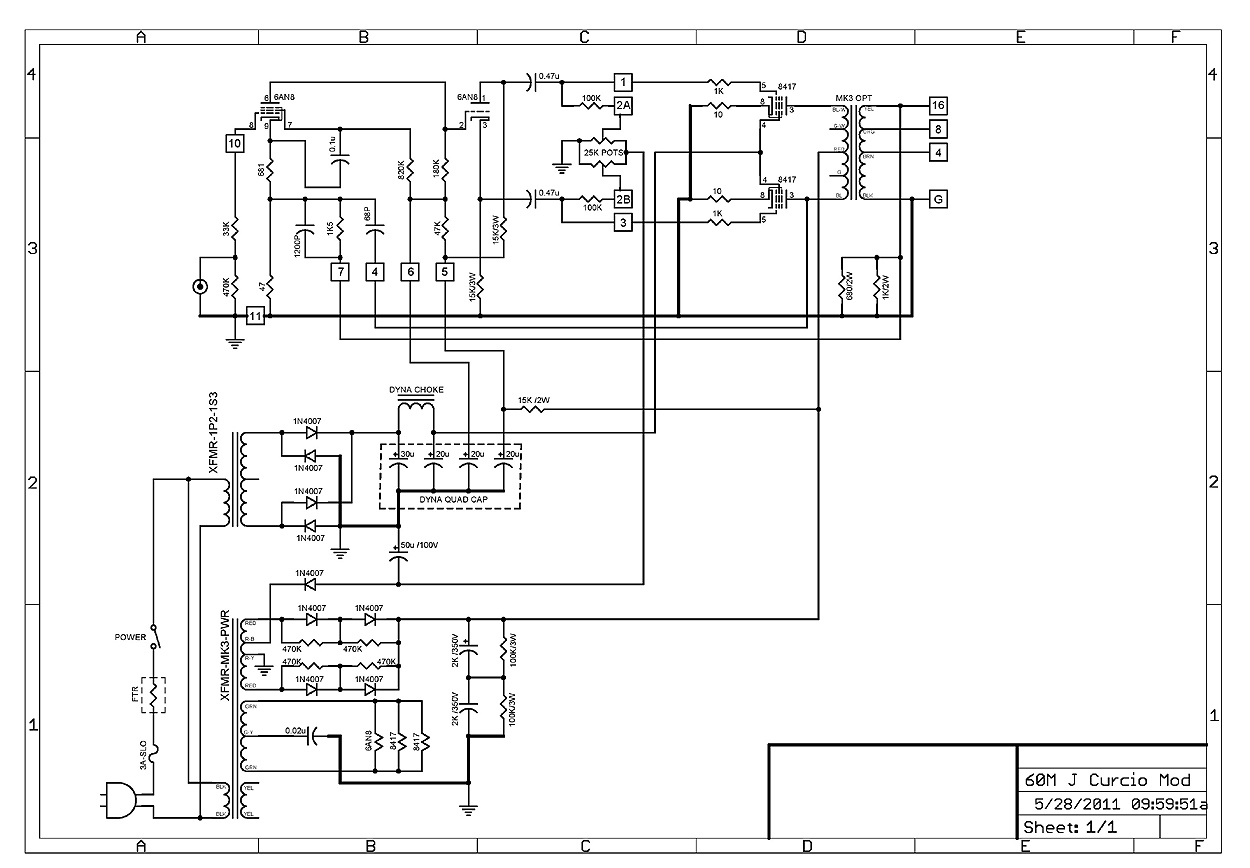 |
Initially, the intent was to preserve the sonic signature of the original design, staying faithful to the coupling caps of that era. However, in the past few years I’ve upgraded to Clarity caps with a significant improvement in upper midrange and treble resolution. It seems to me that in their current version the Paoli 60M betters Audio Research’s designs from the 70s and 80s and I dare say they are still competitive with any push-pull amplifiers in production today. Power response for one of the amps, lifted from Joe Curcio’s detailed report is shown below. It should be obvious that the Curcio-upgraded Paoli 60M outputs high-quality 50 watts of audio power.
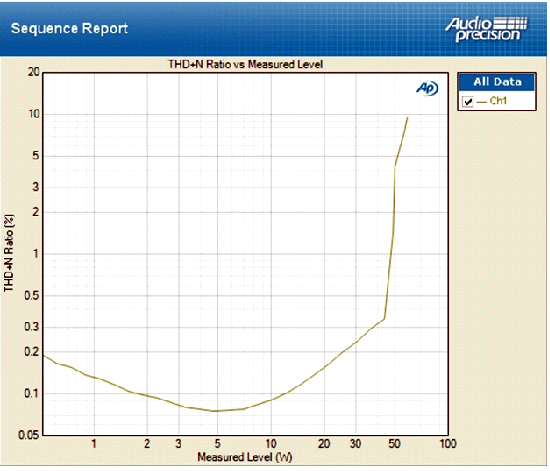 |
Their only limitations (treble extension and resolution) are imposed by the original Dynaco output trannies, which while very good have obviously been surpassed sonically in the past few decades. Still, the Paoli 60M has seen steady work in my reference system in the context of various audio reviews. JGH was right, this is an inherently sweet sounding amp that I’m enjoying as much as he did in its day.
|